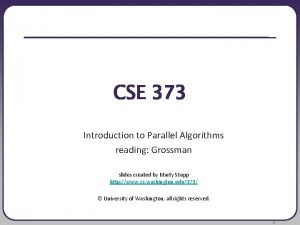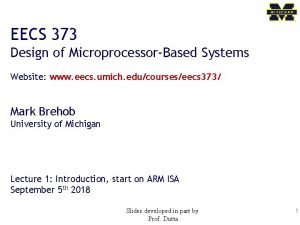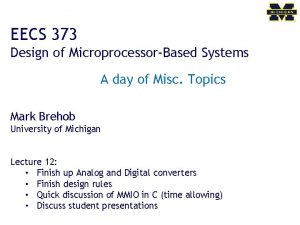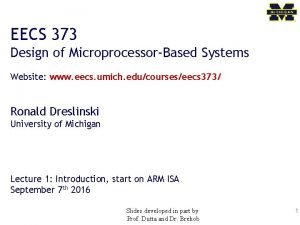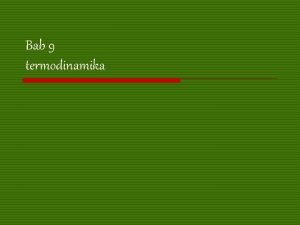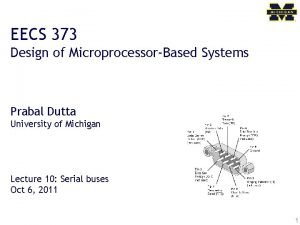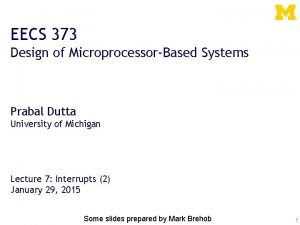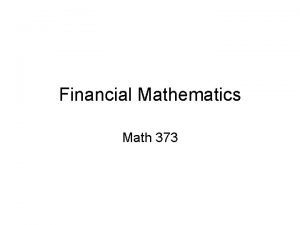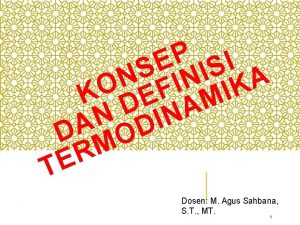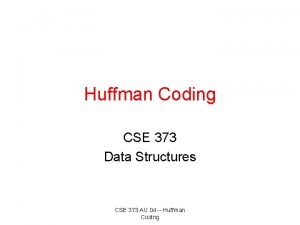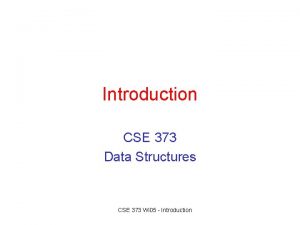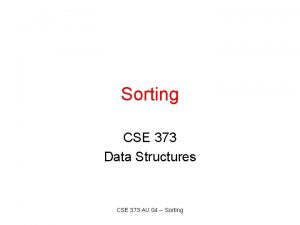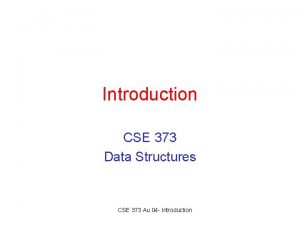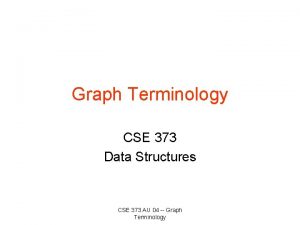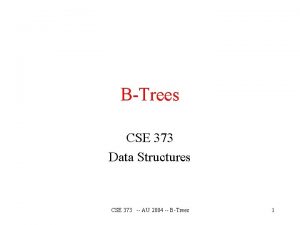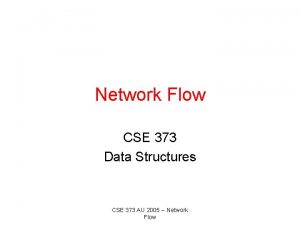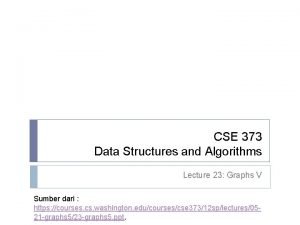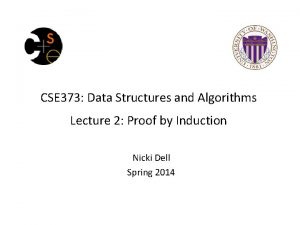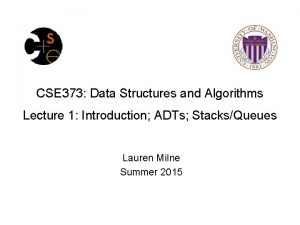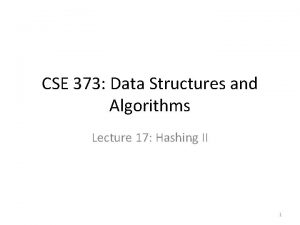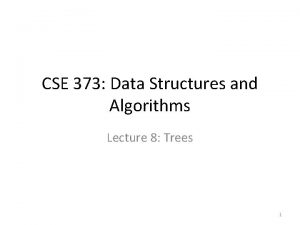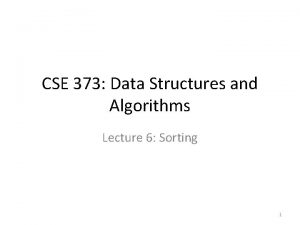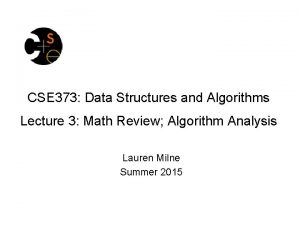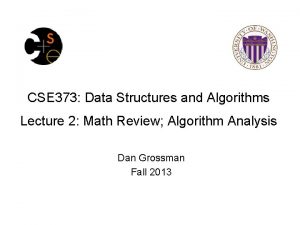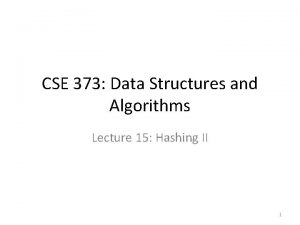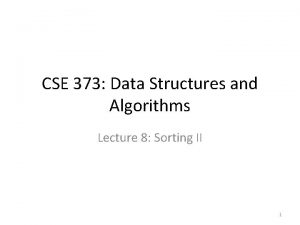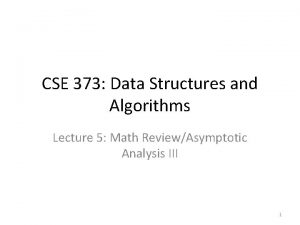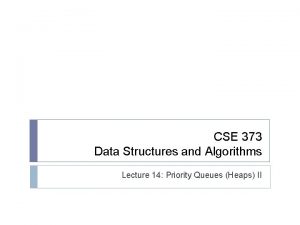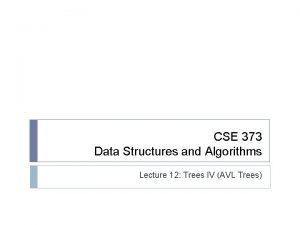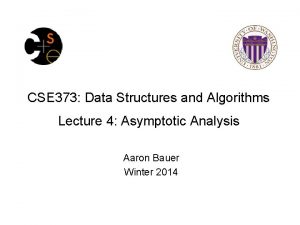CSE 373 Data Structures and Algorithms Lecture 16




























- Slides: 28

CSE 373: Data Structures and Algorithms Lecture 16: Hashing 1

Set ADT • set: A collection that does not allow duplicates – We don't think of a set as having indexes; we just add things to the set in general and don't worry about order • basic set operations: – insert: Add an element to the set (order doesn't matter). – remove: Remove an element from the set. – search: Efficiently determine if an element is a member of the set. contains("to") set. contains("be") "if" "the" "to" "of" "down" "from" "by" "she" "you" "in" "why" "him" set true false 2

Implementing Set ADT Unsorted array Sorted array Insert Remove Search (1) (n) (log(n)+n) (log(n) + n) (log(n)) Linked list (1) (n) BST (if balanced) O(log n) 3

A different tactic • How do you check to see if a word is in the dictionary? – linear search? – binary search? – A – Z tabs? 4

Hash tables • • table maintains b different "buckets" buckets are numbered 0 to b - 1 hash function maps elements to value in 0 to b – 1 operations use hash to determine which bucket an element belongs in and only searches/modifies this one bucket hash func. h(element) elements (e. g. , strings) 0 … b-1 hash table 5

Hashing, hash functions • The idea: somehow we map every element into some index in the array ("hash" it); this is its one and only place that it should go – Lookup becomes constant-time: simply look at that one slot again later to see if the element is there – insert, remove, search all become O(1) ! • For now, let's look at integers (int) – a "hash function" h for int is trivial: store int i at index i (a direct mapping) • if i >= array. length, store i at index (i % array. length) – h(i) = i % array. length 6

Simple Integer Hash Functions • elements = integers • Table. Size = 10 • h(i) = i % 10 • Insert: 7, 18, 41, 34 0 1 2 3 4 5 6 7 8 9 7

Simple Integer Hash Functions • elements = integers • Table. Size = 10 • h(i) = i % 10 • Insert: 7, 18, 41, 34 0 1 2 3 4 5 6 7 8 9 7 8

Simple Integer Hash Functions • elements = integers • Table. Size = 10 • h(i) = i % 10 • Insert: 7, 18, 41, 34 0 1 2 3 4 5 6 7 8 9 7 9

Simple Integer Hash Functions • elements = integers • Table. Size = 10 • h(i) = i % 10 • Insert: 7, 18, 41, 34 0 1 2 3 4 5 6 7 8 9 7 18 10

Simple Integer Hash Functions • elements = integers • Table. Size = 10 • h(i) = i % 10 • Insert: 7, 18, 41, 34 0 1 2 3 4 5 6 7 8 9 7 18 11

Simple Integer Hash Functions • elements = integers • Table. Size = 10 • h(i) = i % 10 • Insert: 7, 18, 41, 34 0 1 2 3 4 5 6 7 8 9 41 7 18 12

Simple Integer Hash Functions • elements = integers • Table. Size = 10 • h(i) = i % 10 • Insert: 7, 18, 41, 34 0 1 2 3 4 5 6 7 8 9 41 7 18 13

Simple Integer Hash Functions • elements = integers • Table. Size = 10 • h(i) = i % 10 • Insert: 7, 18, 41, 34 0 1 2 3 4 5 6 7 8 9 41 34 7 18 14

Hash function example • Desirable properties of a hash function – – efficient computation deterministic/stable result uniformly distributes values over a range • h(i) = i % 10 – does this function have the properties above? • Drawback: lose all ordering information: – get. Min, get. Max, remove. Min, remove. Max – ordered traversals; printing items in sorted order 0 1 2 3 4 5 6 7 8 9 41 34 7 18 15

Hash function for strings • elements = Strings • let's view a string by its letters: – String s : s 0, s 1, s 2, …, sn-1 • how do we map a string into an integer index? (how do we "hash" it? ) • one possible hash function: – treat first character as an int, and hash on that • h(s) = s 0 % Table. Size • Is this a good hash function? When will strings collide? 16

Better string hash functions • view a string by its letters: – String s : s 0, s 1, s 2, …, sn-1 • another possible hash function: – treat each character as an int, sum them, and hash on that • h(s) = % Table. Size • What's wrong with this hash function? When will strings collide? • a third option (polynomial accumulation) – perform a weighted sum of the letters, and hash on that – h(s) = % Table. Size 17

Hash collisions 0 • collision: the event that two hash table elements map into the same slot in the array 1 2 3 • example: add 7, 18, 41, 34, then 21 4 – 21 hashes into the same slot as 41! – 21 should not replace 41 in the hash table; 5 they should both be there 6 7 collision resolution: means for fixing collisions 8 in a hash table 9 21 34 7 18 18

Chaining • chaining: All keys that map to the same hash value are kept in a linked list 0 1 2 3 10 22 12 42 4 5 6 7 8 107 9 19

Load factor • load factor: ratio of elements to capacity • load factor = size / capacity = 5 / 10 = 0. 5 0 1 2 3 10 22 12 42 4 5 6 7 8 107 9 20

Analysis of hash table search • analysis of search, with chaining: – unsuccessful: • the average length of a list at hash(i) – successful: 1 + ( /2) • one node, plus half the avg. length of a list (not including the item)

Implementing Set with Hash Table • Each Set entry adds an element to the table – hash function will tell us where to put the element in the hash table • Hash table organized for constant time insert, remove, and search 22

Implementing Set with Hash table public interface String. Set { public boolean add(String value); public boolean contains(String value); public void print(); public boolean remove(String value); public int size(); } 23

String. Hash. Entry public class String. Hash. Entry { public String data; public String. Hash. Entry next; // data stored at this node // reference to the next entry // Constructs a single hash entry. public String. Hash. Entry(String data) { this(data, null); } public String. Hash. Entry(String data, String. Hash. Entry next) { this. data = data; this. next = next; } } 24

String. Hash. Set class public class String. Hash. Set implements String. Set { private static final int DEFAULT_SIZE = 11; private String. Hash. Entry[] table; private int size; } . . . • Client code talks to the String. Hash. Set, not to the entry objects stored in it • The array (table) is of String. Hash. Entry – each element in the array is a linked list of elements that have the same hash 25

Set implementation: search public boolean contains(String value) { // figure out where value should be. . . int value. Position = hash(value); // check to see if the value is in the set String. Hash. Entry temp = table[value. Position]; while (temp != null) { if (temp. data. equals(value)) { return true; } temp = temp. next; } // otherwise, the value was not found return false; } 26

Set implementation: insert • Similar structure to contains – Calculate hash of new element – Check if the element is already in the set • Add the element to the front of the list that is at table[hash(value)] 27

Set implementation: insert public boolean add(String value) { int value. Position = hash(value); // check to see if the value is already in the set String. Hash. Entry temp = table[value. Position]; while (temp != null) { if (temp. data. equals(value)) { return false; } temp = temp. next; } // add the value to the set String. Hash. Entry new. Entry = new String. Hash. Entry(value, table[value. Position]); table[value. Position] = new. Entry; size++; return true; } 28
 Marty stepp
Marty stepp Professor ajit diwan
Professor ajit diwan Amit agarwal princeton
Amit agarwal princeton Data structures and algorithms tutorial
Data structures and algorithms tutorial Information retrieval data structures and algorithms
Information retrieval data structures and algorithms Data structures and algorithms bits pilani
Data structures and algorithms bits pilani Data structures and algorithms iit bombay
Data structures and algorithms iit bombay Data structures and algorithms
Data structures and algorithms Data structures and algorithms
Data structures and algorithms Ian munro waterloo
Ian munro waterloo Information retrieval data structures and algorithms
Information retrieval data structures and algorithms Data structures and algorithms
Data structures and algorithms Algorithms + data structures = programs
Algorithms + data structures = programs Analysis of algorithms lecture notes
Analysis of algorithms lecture notes Introduction to algorithms lecture notes
Introduction to algorithms lecture notes 01:640:244 lecture notes - lecture 15: plat, idah, farad
01:640:244 lecture notes - lecture 15: plat, idah, farad Homologous structures definition
Homologous structures definition Umich eecs 373
Umich eecs 373 Eecs 373
Eecs 373 Eecs 373
Eecs 373 Cp-cv=r/m
Cp-cv=r/m Dte vs dce pinout
Dte vs dce pinout Eecs 373
Eecs 373 Math 373
Math 373 Suatu gas ideal dimampatkan secara adiabatik
Suatu gas ideal dimampatkan secara adiabatik Eecs 373
Eecs 373 Drg koder
Drg koder Muthukrishnan data stream algorithms
Muthukrishnan data stream algorithms Macro processors
Macro processors
